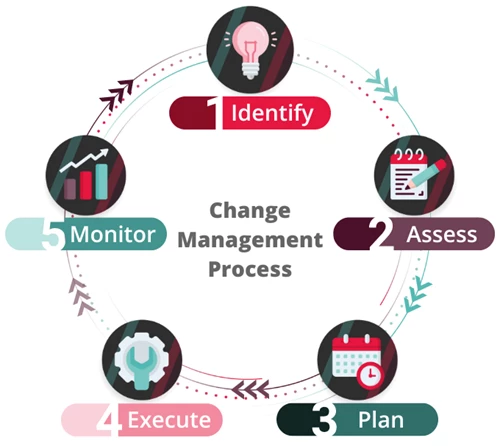4 Steps to overcome resistance to new construction software
Changing technologies within an organisation needs a balance of risk, resistance and reward.
Even when the benefits are clear, transitioning to a new way of working can be a painful task. One major obstacle in adopting new software is individuals’ differing attitudes towards change.

This results in various levels of resistance across the organisation despite a clear business need. Those driving change will encounter pushback from some departments such as IT, purchasing or finance. Even immediate colleagues and peers will be averse to change. However, likeminded individuals will support moving the business forward.
How can you get your colleagues on board with new construction software? We have outlined four stages to overcome resistance to IT investment:
- The process of new software adoption
- Overcoming resistance from individuals
- Overcoming resistance from organisations
- Consider the wider picture
The process of new software adoption
The process of adopting new software within an organisation can be challenging.
Business problems may appear to have a straightforward and logical fix with clear financial benefits. However, there are many other factors to take into account. Complex organisational cultures, departmental silos, ingrained ways of working, individual personalities and hierarchies all play a part. You must consider these elements when seeking to make changes within a business.
Resistance to change can show itself in different ways. It might come from individuals, or as an organisational way of working. This may be formal, for example through agreed organisational policy, or informal - “the way we normally do things”. Both are equally challenging to overcome.
Implementing a change management process provides a structure and plan. This will help diminish the uncertainty and fear around change and allow you to explain the idea more effectively.

There are 5 steps in a change management process:
- Identify the change – What are the main problems with your current way of working? How do you think the software will solve these issues?
- Assess the change – Build a risk assessment, how will the change impact your business? What is the cost and how will individuals or the organisation need to adapt? Weigh up the pros and cons.
- Plan the change – Outline clear steps for before, during and after implementing new software. Who will be involved at each stage? What resources will be needed throughout?
- Execute the change – Implement an action plan, focus on communication and training. How can you best prepare people for a new way of working? Make sure you listen to feedback and set out an escalation process.
- Monitor the change – Evaluate the success of the new estimating software. Track KPIS such as bid wins, time saved on estimating and reduced data errors.
Overcoming resistance from individuals
Within any organisation or team, there are individuals who are keen to adopt new technologies or processes and are very comfortable adapting to new ideas.
These are important people within the change process, they will act as advocates for the change you want to make.
Others are more sceptical. They’re risk-averse, prefer traditional ways of doing things and will only put their resources into a tried and tested solution. Senior colleagues may have been successfully working the same way for 25 years and are resistant to change. But, even if that sounds familiar, it does not mean that the change is impossible to make. Suggesting a solution to a problem is not only a good move for projects but could help gain your acknowledgment and further your career.
Think about how the individuals you’re trying to influence might respond to your suggestion. For example, if you are a junior employee approaching your boss, you will need to make sure you aren’t coming across as condescending. You may come up against a strong preference for another system or a different way of doing things. Or a fear of change in general and ingrained apathy about doing something new. Planning for these responses will make you better prepared to share your vision.
So, what can you do to help overcome this resistance?
1. Demonstrate the return on investment
Show the expected return on investment for the business. Improved margins and business efficiency will benefit everyone and are necessary to ensure that the business stays healthy.
Identify cost and time savings, and ways it will improve the quality of projects or site safety. Better estimates and takeoffs could mean fewer wasted materials. Draw attention to the hidden costs of poor working practices or the costs of errors. Prove that doing nothing is not an option.
2. Set out the benefits to the individual
Once the business case has been made, clearly set out the benefits and advantages of the new software and make them relevant to the individual. Advantages could be less stress, less reliance on manual tasks and more time to concentrate on important or interesting tasks.
3. Have a robust implementation plan
While some people may argue against change based on previous failed IT projects, you can overcome this by working with a trusted and reliable supplier.
Insist your vendor has a proven implementation plan that recognizes and mitigates risk. With clearly defined milestones and responsibilities, you should be able overcome these concerns.
4. Tell them that the decision has been made
Ultimately, driving adoption might come down to pushing the change regardless of cultural apathy or perceived difficulty. For business leaders, their responsibility is growing a stable and effective organisation.
If the steps above do not get the buy-in, sometimes you must move forwards anyway, for the benefit of staff and customers.
Whatever method you try, ensure you have a strong training plan in place to support implementation. Check what training your vendor can provide. Do they offer a mix of classroom-style, onsite, offsite or video training? Try to tailor the training to your users’ needs. Some people may need training in specific modules to see how the software directly solves their problems. Others may need more time to get to grips with a new system and self-learning at their own pace may be more appropriate.
Overcoming resistance from organisations
Organisations and departments themselves are often the main blocker to change. End-users of the software may see the value in a new system, but the final decision sits with the IT department or head office.
Conflict can arise between departments if IT and head office aren’t aligned with end-user needs. Differing time and cost priorities will cause friction. If an IT department is tasked with choosing new construction software, they may struggle to make informed decisions without input from end-users. Back-office teams, for example, want software that is practical and beneficial for their way of working. IT will focus more on integration with existing systems, licensing and costs. Good collaboration and detailed information from end-users are crucial for successful software purchases.
How to make construction estimates more accurate in six steps >
It’s evident that company buying processes are complex. So, what’s the best way to overcome these challenges?
1. Understand who needs to be involved
Firstly, understand the individual roles within your organisation’s buying process. Who needs to be involved in the decision? Who will have ultimate sign-off? This may not be immediately obvious, so prepare for more people to become involved as you move through the process.
2. Keep it relevant
What information do those individuals and departments need to make an informed decision? How do they want that information presented? Remember that individuals do not all need the same type of information or amount of detail. If you don’t know, don’t be afraid to ask.
3. Make a clear business case
Make a clear business case for the purchase and back it up with facts, statistics, examples and testimonials. Make sure you include the cost to the organisation of doing nothing. Be clear that retaining the status quo is not an option.
4. Provide the opportunity for feedback
Develop a strong communication strategy. Transparent communication makes people more comfortable giving feedback. Ensure you provide an opportunity for individuals to ask questions and receive support. Don’t give up at this stage. Be ready to follow up with more information and proof before you have every person or department on side. Understand that the whole process may take more time than you planned.
Consider the wider picture
When considering new software, you will need to convince your colleagues, IT department and management that it will benefit the organisation. Make sure you arm yourself with the right information and understand the roles of everyone involved in the decision.
While it may appear easier to accept the status quo, don’t be tempted to take the path of least resistance. Accept that change is never easy. Making decisions that will benefit the whole business may inconvenience some individuals.
End-users need to see the benefit of change and how it will enhance their day-to-day work. Remember that not everyone will be keen to implement a new system or to learn a new way of doing things. If little behaviour change is needed, then adopting new technology will be faster and easier. Conversely, if the new software requires an entirely new way of working, then set aside more time for training and support.
Tasked with reviewing the options available to your team? Trying to persuade others to invest? Dealing with a resistant manager or team? Use the guides above to help form your case. Finally, never underestimate the power that the individual has within this process, either as a champion or a detractor.
Have a look at the construction software available from The Access Group.









